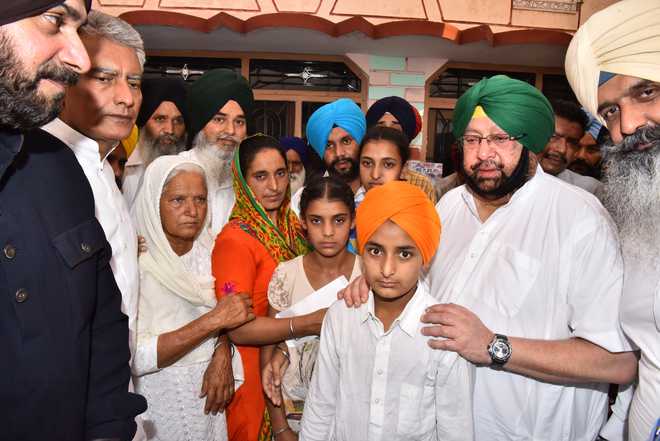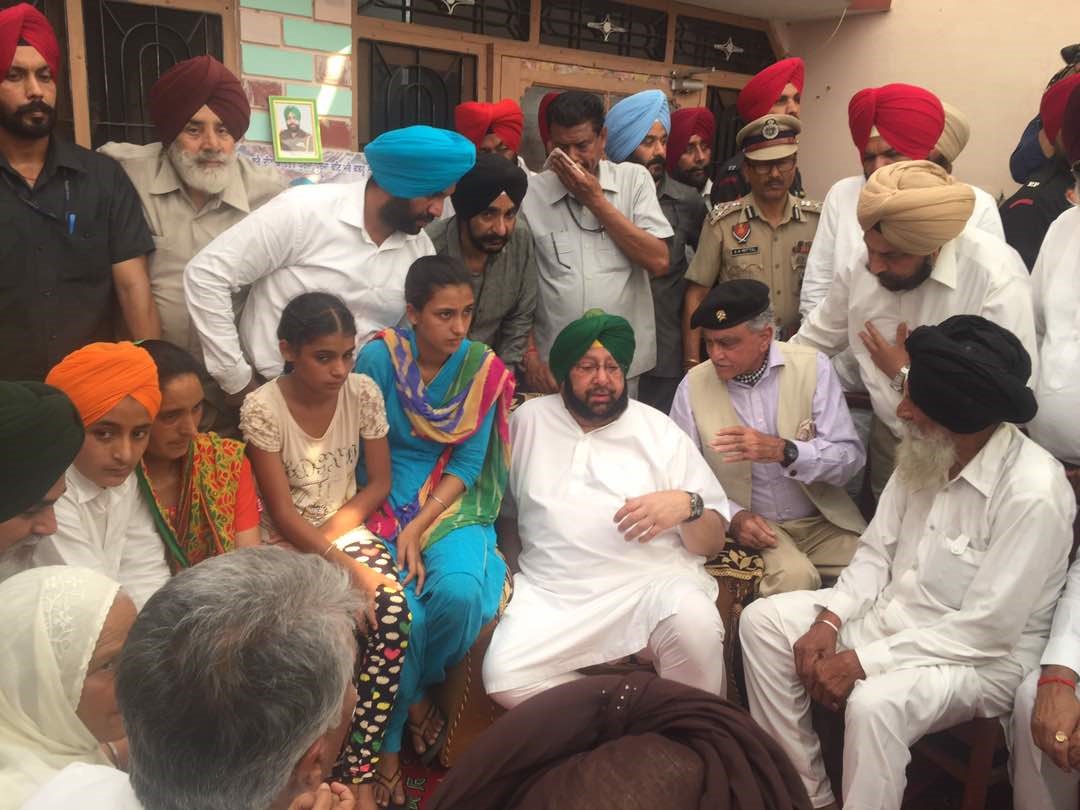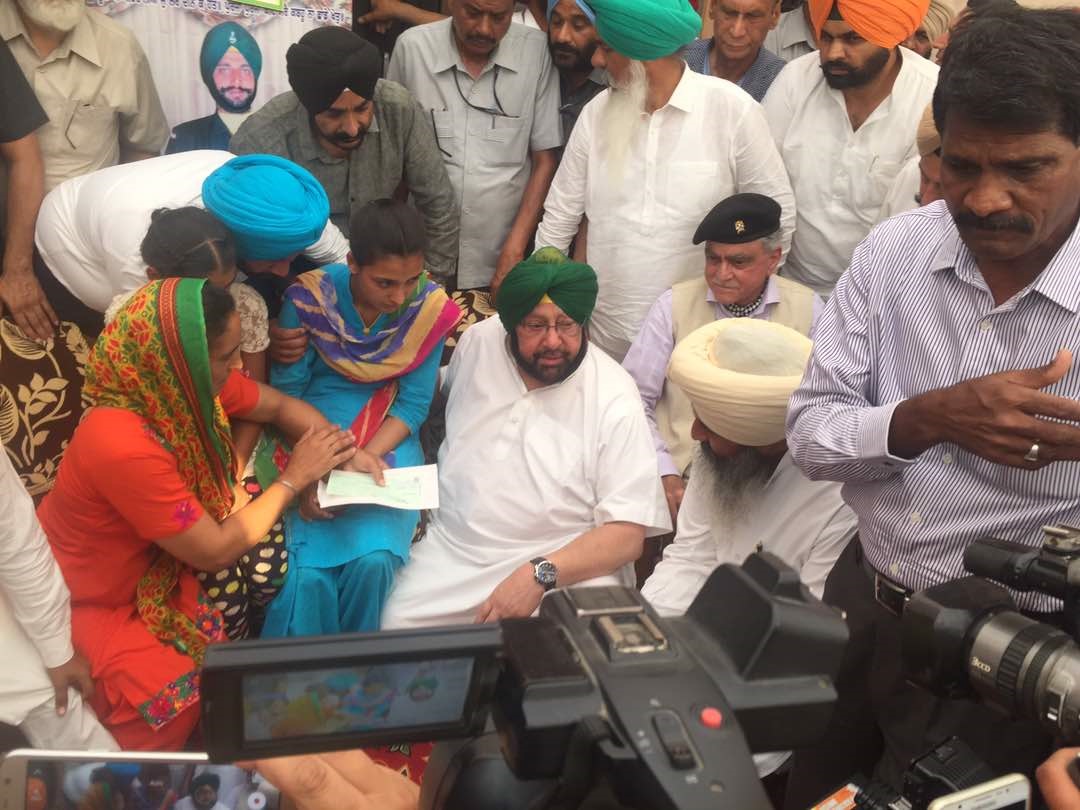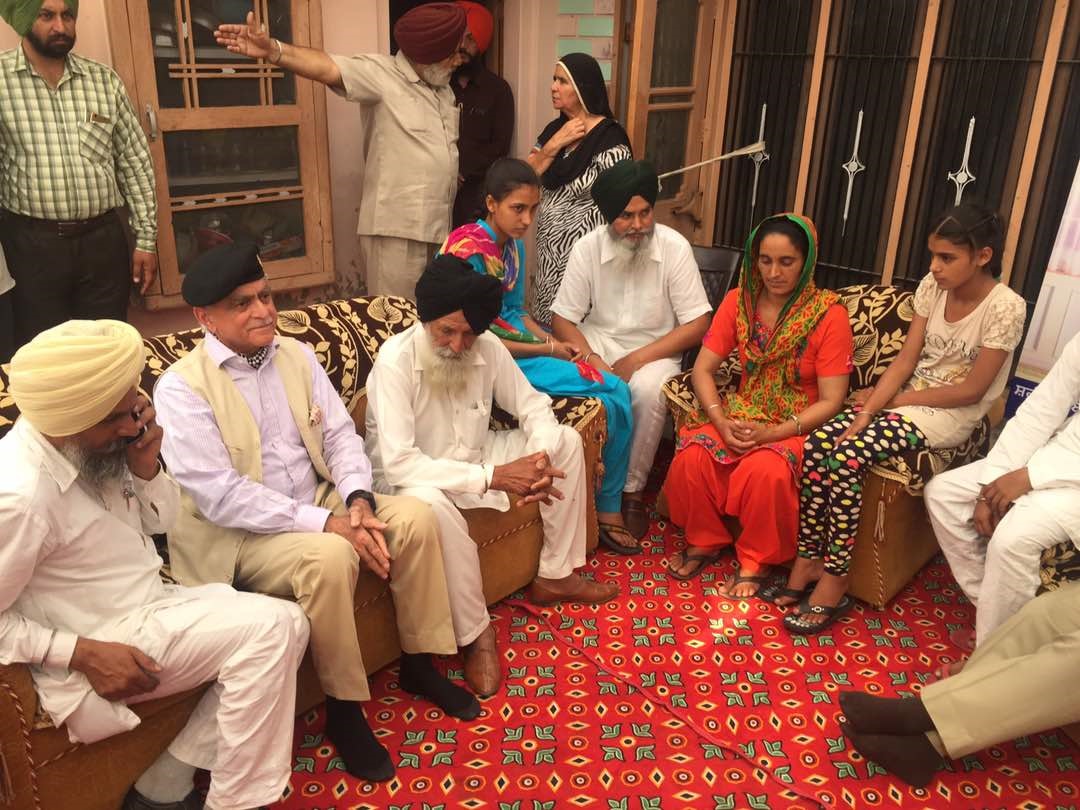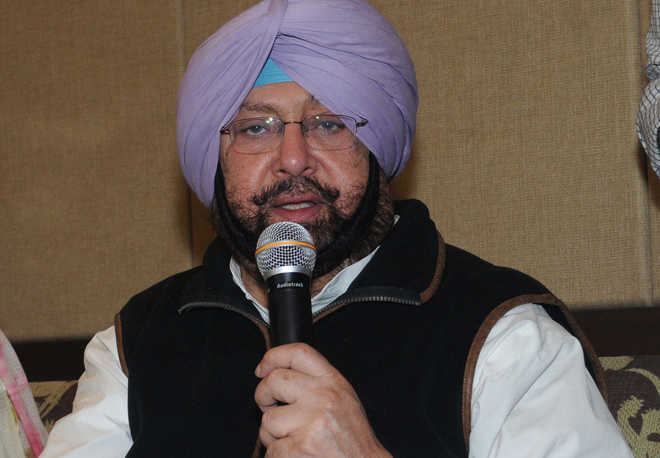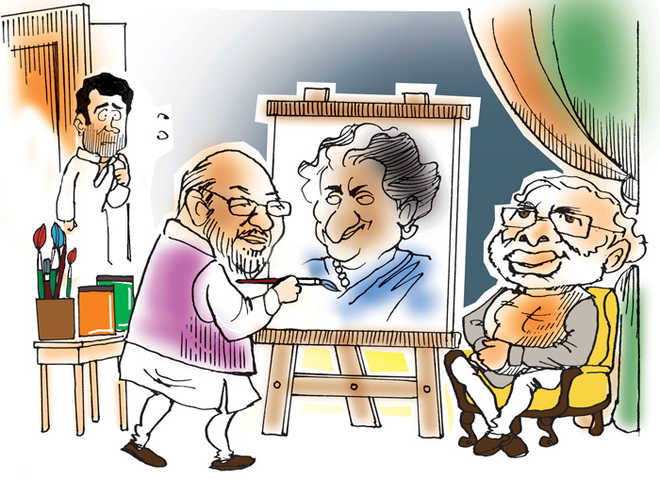2 pvt producers got Rs 900 cr for no generation of power
Ruchika M. Khanna
Tribune News Service
Chandigarh, May 8
Two private power producers in Punjab were paid an estimated Rs 900 crore during 2016-17 as fixed charges and not for generating electricity, a technical audit has revealed.Twelve other power-generation plants — owned by the National Thermal Power Corporation and National Hydro Power Corporation — got Rs 600 crore as fixed charges for non-purchase of power during the time these were ready to generate at optimum capacity.(Follow The Tribune on Facebook; and Twitter @thetribunechd)The fixed charges paid to the 14 companies form the basis of the technical audit of all power purchase agreements (PPAs) signed by the cash-strapped Punjab State Power Corporation Limited (PSPCL) on behalf of the Punjab Government.Power Minister Rana Gurjit Singh, after assuming office, had said that he wanted to review all power purchase agreements by the previous SAD-BJP government. The Capt Amarinder government said the review should be carried out within four months.A preliminary examination of PPAs revealed that the fixed cost paid to Nabha Power Limited was Rs 1.44 per unit of power not bought by the state, and Talwandi Sabo Power Limited Rs 1.20. In comparison, most public sector plants supplying power to Punjab were getting 50 paise to Re 1 per unit as fixed cost, barring one or two, where the fixed cost was as high as Rs 1.46 (from the gas-based plant).The penalty clause in these PPAs will also be examined in the audit.
No jeans, tops for women teachers in Punjab

Order says bright suits, fashionable dresses ‘excite’ school kids; regular checks mus
maninder Pal
Tribune News Service
Chandigarh, May 8
Diktats on what to eat or wear, especially in case of women, may sound medieval. But the Punjab Education Department, incidentally headed by a woman Cabinet minister, has done just that by issuing an order stating “jeans, tops, bhadkeela pehrawa (bright suits) and fashionable dresses” worn by women teachers in government schools “excite” students and have a bad influence on them.(Follow The Tribune on Facebook; and Twitter @thetribunechd)Laced with vocabulary reflecting patriarchal mindset and “specifically” addressing dressing culture of women employees, who constitute more than half of the employment base of the department, the order directs all district officials to conduct regular checks in schools to ensure no woman teacher wears such clothes.“We are receiving complaints that teachers in government schools, especially female teachers, are delivering their duties while sporting bhadkeela pehrawa. Some lady teachers wear jeans, tops and other many more exciting fashionable dresses during their duty hours. This affects students,” reads the circular issued to all Circle Education Officers and District Education Officers of the state.Teachers termed it a “Talibani farmaan” (Taliban decree) that was “reactionary” and “immature” in nature.A report on whether the dress code is being followed in schools or not is to be regularly submitted to the office of Director, Education (Senior Secondary).“As it affects students, dress code should be implemented. Regular checks should be conducted to ensure it is being followed,” reads the order.
Will withdraw letter: GovtLetter has been issued without my nod and knowledge. We will withdraw it —SS Kahlon, Director Public Instructions Such vocabulary should not be used. This letter’s been issued with reference to old order of 2012. We’ve summoned officials who issued letter. —TPS Sidhu, Joint Secy, Education Reactionary, immature: TeachersNot only unnecessary and immature, this order is reactionary in nature and reflects patriarchal mindset of those sitting in high offices. It reflects authorities’ immaturity pertaining to gender issues— Surjeet Singh of Government Teachers’ Union, Punjab
SGPC honours Capt at Golden Temple
Sikh body had denied him siropa in 2002 during his previous tenure as Chief Minister
Chief Minister Capt Amarinder Singh is flanked by state Congress president Sunil Jakhar and Local Bodies Minister Navjot Singh Sidhu at the Golden Temple on Monday.

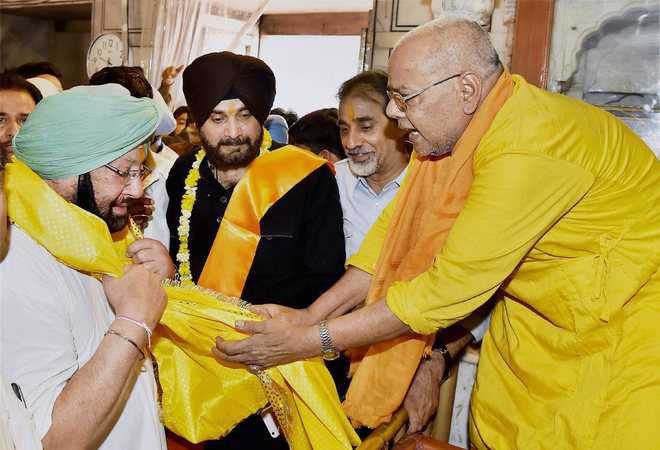
GS Paul
Tribune News Service
Amritsar, May 8
The Shiromani Gurdwara Parbandhak Committee (SGPC) honoured Capt Amarinder Singh here today during his maiden visit to the Golden Temple after taking charge as the Chief Minister, 15 years after it had denied him a siropa (robe of honour) during his previous tenure as the CM.Kirpal Singh Badungar was heading the Sikh body in 2002 as well. Former SGPC presidents Bibi Jagir Kaur and Gurcharan Singh Tohra had condemned the then management for snubbing the CM.Badungar was not present today due to health reasons, according to SGPC chief secretary Harcharan Singh. The SGPC chief had recently said that Capt Amarinder would be welcomed at the shrine.The CM reached the Golden Temple at 7.15 am. Despite his foot injury, he completed a round of the parikrama and offered prayers at the sanctum sanctorum.He was honoured with a siropa by the shrine’s head priest, Jagtar Singh. Thereafter, he was presented with a siropa, a shawl, Golden Temple’s framed picture and a set of religious books by the shrine’s manager, Sulakhan Singh, in the presence of Harcharan Singh and SGPC secretary Dr Roop Singh.Later, the CM paid tributes to the martyrs at Jallianwala Bagh. He was accompanied by PPCC chief Sunil Jakhar; Cabinet ministers Navjot Singh Sidhu, Manpreet Singh Badal and Rana Gurjit Singh; local MP Gurjit Singh Aujla; Congress MLAs Sunil Dutti and Inderbir Singh Bolaria; and party leaders Jasbir Dimpa and Dinesh Bassi.He also paid obeisance at the Durgiana Mandir and Ram Tirath Sthal before leaving for Hoshiarpur.Khalsa College suicide: CM promises justiceAmritsar: Capt Amarinder Singh on Sunday met Khalsa College students who had locked horns with the management over the suicide by a student, Harpreet Singh. The CM directed Principal Secretary (Higher Education) Anurag Verma to probe the incident and ascertain the management’s role. He assured Harpreet’s father Yadwinder Singh that anyone found guilty of abetment to suicide would be punished. The CM said the police had formed an SIT to investigate the case. In a letter to the CM, Yadwinder sought Rs 50-lakh compensation and a job for his younger son. The letter was also signed by gram panchayat members and residents of Harpreet’s village, Gumti Kalan. An FIR has already been filed against the college principal, registrar and head of its agriculture department. Harpreet’s attendance at college had been low as he was attending coaching classes with the aim of getting admission in the MSc course in another institution. TNS
‘Non-VIP’ minister
- Finance Minister Manpreet Singh Badal stood in the queue for ordinary devotees before entering the sanctum sanctorum, whereas the CM and his other Cabinet colleagues preferred to take the VVIP passage to pay obeisance at the Golden Temple.
Denied honour in 2002, Amarinder given ‘siropa’ inside Golden Temple CM promises fair real estate policy
It was Capt’s first visit to the shrine after becoming Punjab CM
SAYS WILL ALSO EXAMINE WHAT STEPS CAN BE ‘LEGALLY’ TAKEN TO HELP HOTELIERS HIT BY SUPREME COURT’S LIQUOR BAN ALONG HIGHWAYS
AMRITSAR : Contrary to its 2002 stand, the Shiromani Gurdwara Parbandhak Committee (SGPC) on Monday honoured Punjab chief minister Captain Amarinder Singh with a ‘siropa’ (robe of honour) at the Golden Temple here on Monday.
 HT PHOTOChief minister Capt Amarinder Singh also visited Durgiana Temple in Amritsar on Monday.
HT PHOTOChief minister Capt Amarinder Singh also visited Durgiana Temple in Amritsar on Monday.
The chief minister, who reached the Golden Temple early in the morning, did a ‘parikrama’ of the holy shrine before offering prayers at the sanctum sanctorum, where head granthi Giani Jagtar Singh presented him the ‘siropa’. Later, the SGPC executive members and office-bearers also honoured him inside the information office.
However, SGPC chief Kirpal Singh Badungar remained absent due to health issues, said the sources. SGPC chief secretary Harcharan Singh was though present throughout.
Amarinder was denied the ‘siropa’ during his visit to the shrine after becoming the chief minister in 2002, which had evoked a sharp reaction. Though the SGPC honoured him with the ‘siropa’ in 2004, but it was not inside the sanctum sanctorum. This time, when Amarinder became the chief minister, SGPC chief Kirpal Badungar had announced beforehand that the CM will be given ‘siropa’ when he visits the Golden Temple.
CM SEEKS BLESSINGS
From the Golden Temple, Amarinder went to Jallianwala Bagh and then to the Durgiana Mandir. The CM and his colleagues later visited Sri Ram Tirath Sthal to offer prayers before leaving for Hoshiarpur, to inaugurate a new tractor manufacturing facility.
In statement, Amarinder said it was a gratifying experience for him to visit the holy shrines, “which are a fountainhead of peace for millions of people from around the world”.
He said he and his colleagues wished to express their gratitude to God for their victory in the recent Punjab assembly elections. He said they had come to these temples to pray for the state, and its peace and development.
Among those who accompanied him were the newly appointed state Congress chief Sunil Jakhar, Amritsar MP Gurjit Singh Aujla, cabinet ministers Manpreet Singh Badal, Rana Gurjit Singh, Navjot Singh Sidhu and Sadhu Singh Dharmsot. MLAs of Amritsar district and Jalandhar Cantt legislator Pargat Singh were also present. HOSHIARPUR: Chief minister Captain Amarinder Singh on Monday said the new real estate policy in the state would be made in consultation with all stakeholders, promising a fair play to hotel associations and property dealers here.
The CM was presented a memorandum by the two associations on Monday in which they kept their demands regarding the formulation of new real estate policy. Amarinder said he would examine what steps his government could “legally” take to help the hotel industry recover from the “adverse impact” of the Supreme Court ban on sale of liquor along the highways.
INAUGURATES TRACTOR PRODUCTION FACILITY
The CM also inaugurated a new state-of-the-art tractor production facility of International Tractors Limited (ITL), describing it as a major asset for the state’s progress. Rolling out the first tractor, the CM termed the new plant as a major achievement for Punjab, which was heavily dependent on agriculture for its growth and development. The ITL claimed that the new facility was world’s largest integrated tractor plant, with a total capacity of 3 lakh tractors annually.
Inspecting the plant, the CM said that the high-end tractors being manufactured at the plant under the brand name of Sonalika would be beneficial to the state’s farmers, who needed modern equipment to improve their crop yield and quality.
The inaugural event was attended by the top management of the company, including chairman LD Mittal, vice-chairman Amrit Sagar Mittal and managing director Deepak Mittal.
On the occasion, the management presented a cheque for ₹1.01 crore for the Chief Minister’s Relief Fund. They also presented a tractor to the CM who gifted the same to Citrus Estate in Chhauni village, which he had visited earlier in the day.
 To mark the CM’s visit, ITL announced the adoption of Chhauni Kalan to transform in a world-class village.
To mark the CM’s visit, ITL announced the adoption of Chhauni Kalan to transform in a world-class village.
Ensure security of Sikhs in US, CM tells Centre
Chandigarh, May 8
Concerned over the spurt in attacks on Indians, including Sikhs, abroad, Chief Minister Captain Amarinder Singh has urged the Centre to ensure their protection and take up such issues in “right earnest”.Amarinder had raised concern over the recent killing of a Kapurthala man, Jagjeet Singh (32), in the US in a suspected hate crime case.He was stabbed to death by an unidentified person allegedly over cigarettes outside a grocery store in California.In response to the CM’s tweet, External Affairs Minister Sushma Swaraj said she had spoken to the Indian Ambassador in Washington, Navtej Singh Sarna, on the issue.Raveen Thukral, media adviser to CM, said Amarinder was concerned over the recent spurt in hate crimes against Indians, mainly Sikhs, in the US and other parts of the world.The CM has said the US alone had witnessed several such attacks on Sikhs, who have been at the receiving end of the growing bigotry in the country and demanded immediate steps to ensure their protection. The Centre, he said, needed to adopt a more proactive stance to put pressure on the US to crack down on racist elements and provide fool-proof protection to the Sikh community. — PTI
Need-based changes in Cong unit on cards
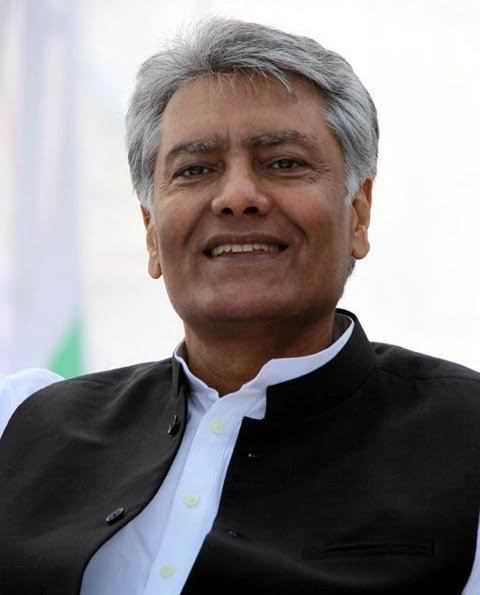 Sunil Jakhar
Sunil JakharTribune News Service
Chandigarh, May 8
Punjab Pradesh Congress Committee (PPCC) chief Sunil Jakhar today hinted at rationalising the state body, wherever required.He will formally take over as the state Congress chief at the PPCC office here on May 10. Chief Minister Capt Amarinder Singh, Punjab affairs in-charge Asha Kumari and Congress secretary Harish Chaudhary would be present.A former Congress Legislative Party (CLP) leader and three-time MLA from Abohar, Jakhar will replace Capt Amarinder as the PPCC chief. Capt Amarinder had resigned from the post during a meeting with Congress vice-president Rahul Gandhi on April 12.Jakhar said the present PPCC team appointed by Capt Amarinder had done extremely well. “As some of the leaders have been become ministers or have been given other responsibilities in the government, some changes may be required.”On his agenda would be to share information on the foodgrain scam, scam in setting up of private thermal plants and other matters raised by him in the run-up to the Assembly elections. “The government is already on the job and I will be sharing the information as and when required,” Jakhar added.
Chandigarh-based doctor adopts martyr’s daughter
Tribune News Service
Amritsar, May 8
MP Gurjeet Singh Aujla along with Dr Gurmohan Singh (a Chandigarh-based nephrologist) and Jaspal Singh Sandhu, a local businessman, and others visited the family of Naib Subedar Paramjit Singh, who was killed by the Pakistani army along the Line of Control in the Poonch Sector.Motivated by Aujla, Dr Gurmohan has adopted the martyr’s elder daughter, Simrandeep Kaur, and offered to bear the expenditure of her education and marriage.The Deputy Commissioner of Kullu and his wife have already adopted the younger daughter, Khushdeep Kaur. Talking about his inspiration, Dr Gurmohan Singh said he had seen a dream 33 years ago in 1984 that he should adopt the families of soldiers and policemen who were in killed in trains and at the railway station, but it didn’t materialise due to lack of funds and other issues. He had earlier adopted a Dalit girl in Chandigarh. He offered to sponsor the study of Simrandeep Kaur in the best school in Chandigarh, Amritsar or any other school of the family’s choice. He also proposed to open a bank account in the name of Simarndeep and deposit the first instalment to meet her expenses.Speaking on the occasion, Aujla said that Paramjit would be remembered alongwith those who laid down their lives for the country and it is an honour for them to do something for the family. He said the bravehearts of their nation were standing shoulder to shoulder with the armed personnel of India.Dr Gurmohan Singh said Naib Subedar Paramjit Singh laid down his life for the nation and it was their duty to help his dependents.
70 yrs on, holy city holds on to its British legacy
HOUGH RECHRISTENED AFTER INDEPENDENCE, MANY ROADS, OTHER PLACES STILL KNOWN BY THEIR COLONIAL NAMES
AMRITSAR: Even as the British rulers left the country around 70 years ago, their legacy still survives, especially in the holy city.HTHall Gate, built in 1873 and named after the then deputy commissioner CH Hall, was renamed Gandhi Gate after Independence. In view of the original name’s popularity, the Punjab tourism department has mentioned it on signboards on both sides of the gate.
Although various places, predominantly roads, were given Indian names by the administration subsequently, these remain only on paper. In practice, the original names given by the British rulers remain popular among locals and tourists alike.
On entering the walled city from the west side, there is a famous gate that was constructed in 1873. The gurbani slogan ‘Amritsar Sifti Da Ghar’ (Amritsar is a home of values) is installed atop it. The gate is famous as Hall Gate after the then deputy commissioner CH Hall. Even as it was rechristened Gandhi Gate after independence and the new name can be seen written on it, the old name persists.
In view of its popularity, the Punjab tourism department has in fact mentioned the old name on boards on both its sides. Even the famous market situated along the stretch between this gate and the historic Town Hall building is popular as Hall Bazaar.
The Civil Lines, one of the posh localities of the city, was developed by the British officers on the north side of the old city. Lawrence Road constructed near the historic Ram Bagh garden in 1870 was named after the British official John Lawrence. The officers used this road to commute, and Indians were not allowed to reside near it. However, the legendary Punjabi poet Bhai Vir Singh, who belonged to an affluent family, managed to build his house on this road. In view of his contributions, the civic body renamed this road after him, but only on paper. The signboards still call it Lawrence Road.
The road connecting the Sadar police station to the cantonment area was named after the then finance commissioner FC Mcleod in 1853. Although the administration renamed it after Pundit Lal Chand Changotra, people are oblivious to this fact. The same has been the fate of Queens Road and Cooper Road (both between Bhandari Bridge and the district courts), Mall Road (Novelty Chowk to Court Chowk), Taylor Road (connecting Mall Road to Court Road), and Albert Road (between the railway station and Mall Road).
QUEEN VICTORIA TRUMPS MAHARAJA RANJIT SINGH
The Ram Bagh garden, developed by Sikh ruler Maharaja Ranjit Singh in the memory of Guru Ram Das, founder of the holy city, was renamed Company Bagh by the British administration. Even today, this new name remains popular.
In 1887, the colonial rulers installed a statue of Queen Victoria on the chowk situated on the way to the Golden Temple near the Dharam Singh market. Both the chowk and the market were rechristened after her. Later, the Queen’s statue was removed, and recently the Punjab government installed a huge statue of Maharaja Ranjit Singh here. The locals, however, still call it by the colonial name, which as the names of other places has been passed down from one generation to the other since 1947.
















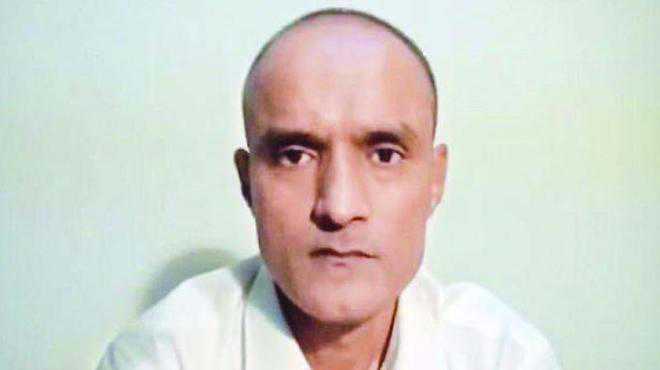
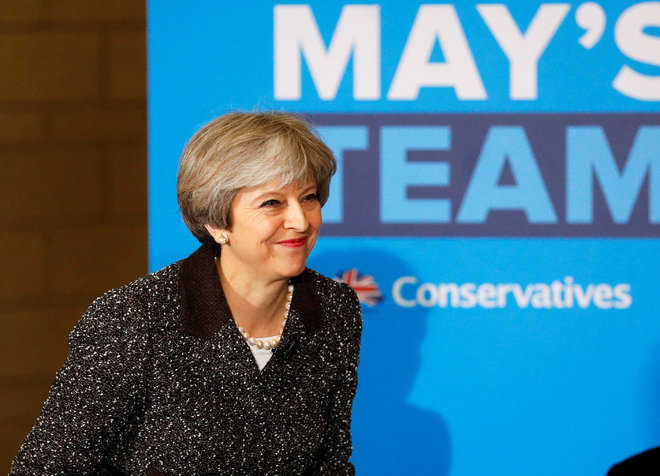

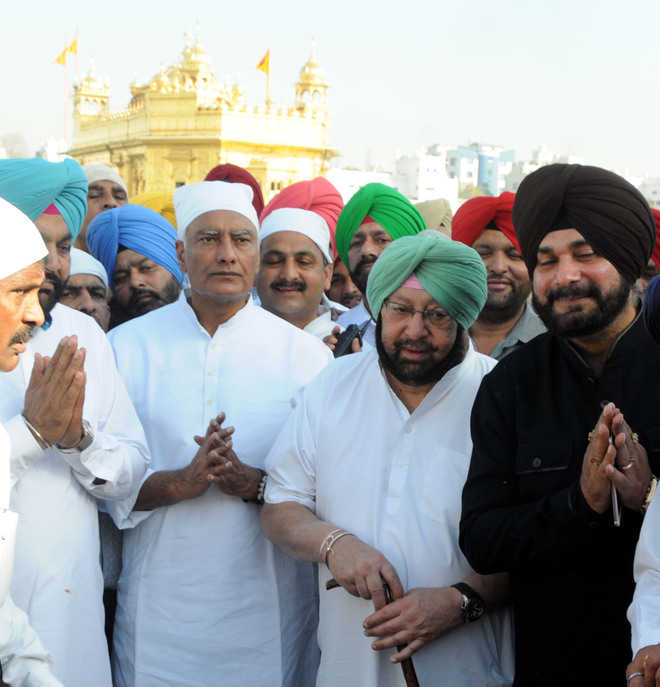


 HT PHOTO
HT PHOTO



